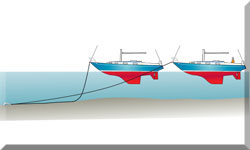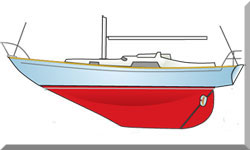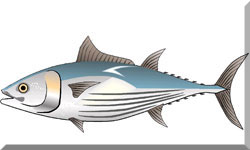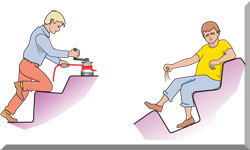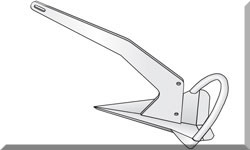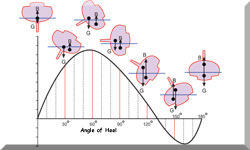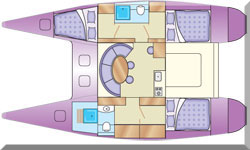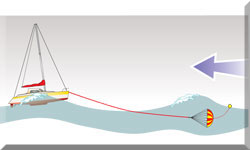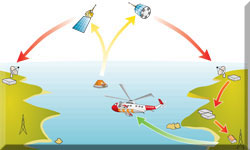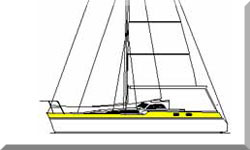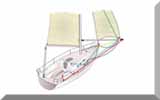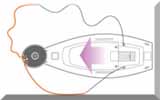- Home
- Cruising Sailboats
- Sailboat Propellers
The Essential Guide to Sailboat Propellers: Selection, Maintenance & Performance
In a Nutshell...
- Sizing: Set WOT RPM within the engine's specified range. A 2-inch pitch change equals about 400 RPM.
- Feathering & Folding: Choose these options to reduce drag significantly (saving up to 1.5 knots) compared to a fixed prop.
- Corrosion: Replace sacrificial anodes when 50% worn. If they disappear fast, suspect dangerous electrolysis.
- Cavitation: Causes noise, vibration, and pitting. Prevent it by correctly propping your engine and maintaining a smooth blade surface.
- Hydrogeneration: Variable-pitch propellers are the most efficient way to turn sailing motion into electrical energy for your batteries.
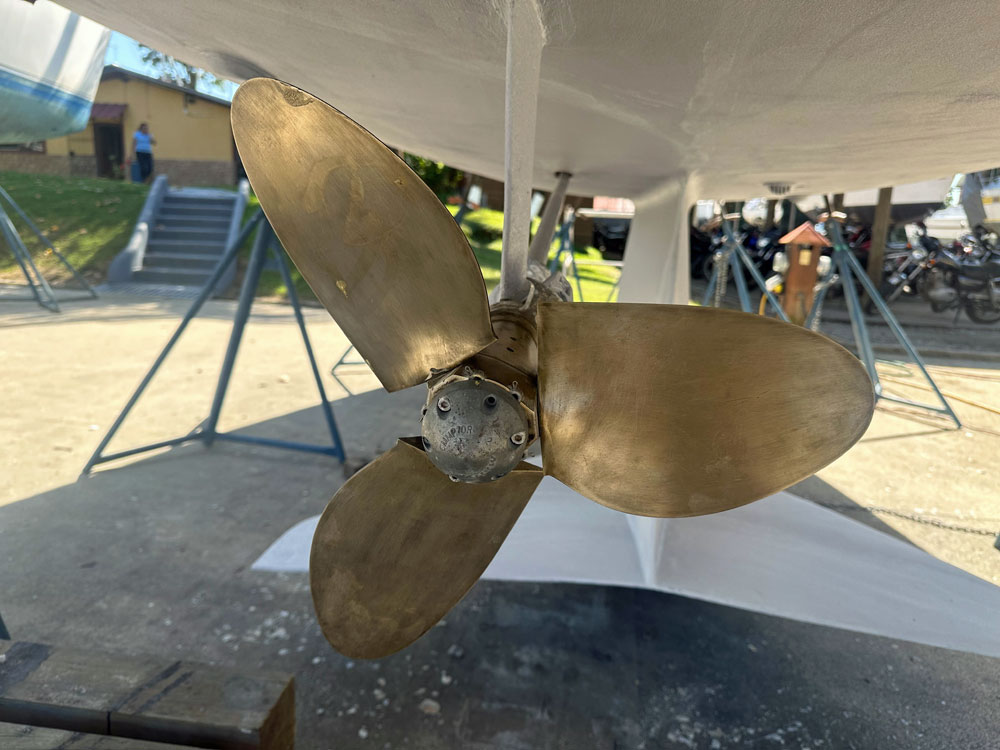 A 3-bladed feathering prop like this one will offer very little drag under sail
A 3-bladed feathering prop like this one will offer very little drag under sailTable of Contents
Propellers are often the most overlooked component on a sailboat, yet they are crucial for safety, manoeuvrability, and performance when the wind dies. As an ocean sailor, you know that a reliable auxiliary engine and an efficient propeller are non-negotiable for getting you out of a tight spot or back to your berth.
Understanding how a propeller works and choosing the correct one for your yacht is essential for maximising your engine’s power and reducing drag under sail.
Understanding Propeller Fundamentals
Every propeller is defined by two key measurements, always written as Diameter × Pitch. Think of them as the DNA of your prop.
- Diameter: This is simply the circle made by the blade tips when they spin. Bigger diameter generally suits heavier, slower displacement hulls, giving you more low-end push.
- Pitch: Imagine the propeller as a screw in wood. The pitch is the theoretical distance, in inches, it would move forward in one turn. High pitch is like a high gear; it gives more speed per rev but makes the engine work harder, which can lead to 'lugging' if you get it wrong.
Propeller Sizing & WOT RPM
Nailing the propeller size for your yacht and engine is critical—it’s how you keep your engine happy and efficient. The absolute rule is to match your prop to your engine’s recommended Wide Open Throttle (WOT) RPM range.
- Pitch is too High: Your engine will be 'lugged' (over-loaded), preventing it from hitting its minimum WOT RPM. This is a common killer of marine diesels due to excessive stress.
- Pitch is too Low: Your engine will 'over-rev' past the maximum recommended WOT RPM, which can also cause significant damage.
If your engine's off, you can typically correct this by adjusting the pitch: a 2-inch pitch change usually results in a shift of about 200 to 400 RPM in the opposite direction. If you're over-revving, add pitch. If you're under-revving, subtract pitch.
Propeller Types & Sailing Performance
The biggest headache for any sailboat owner is the propeller acting like a sea anchor. When the engine's off, you want that prop to disappear.
| Propeller Type | Description | Key Advantage | Sailing Drag | Ideal Application |
|---|---|---|---|---|
| Fixed | Solid, non-moving blades. Simple, robust, and the cheapest option. | Gives maximum thrust in forward gear. | High (it’s a major 'brake' under sail). | Yachts where pure sailing speed is not the priority. |
| Folding | Blades tuck back neatly into a low-drag cone when the shaft stops. | Excellent sailing performance with ultra-low drag. | Very low. | Racing yachts and performance cruisers. |
| Feathering | Blades pivot to align perfectly with the water flow. | Superb in both forward and reverse, often offering better reverse control than folders. | Low. | Serious offshore cruising and blue water yachts. |
| Variable Pitch | Blade angle can be adjusted on the fly, often electronically. | Optimises pitch for speed, torque, and even hydrogeneration. | Very low (can also feather). | High-end electric propulsion or modern cruising yachts. |
The Drag Factor: Fixed vs. Low-Drag Props
As an experienced sailor, you know that drag is the enemy of boat speed. A fixed propeller on a moderate 40-foot cruising yacht, even when locked, can easily rob you of anywhere from 0.5 to 1.5 knots in a decent breeze. That's unacceptable. By contrast, a feathering or folding propeller reduces this performance loss to a negligible whisper, often less than 0.1 knot. This huge performance difference is why a good low-drag prop is an investment that pays dividends on every long passage.
Propeller selection is intrinsically tied to a vessel's design, and a low-drag setup is just one factor contributing to a safe, efficient passagemaker. For a broader perspective on what makes a vessel suitable for ocean voyages, review our guide on The Essential Features of All Good Cruising Sailboats.
Maintenance & Critical Issues
Propeller Cavitation & Vibration
Cavitation is when the pressure on the suction side of the propeller blades drops so low that the water actually vaporises, forming tiny bubbles. When these bubbles move into a higher pressure zone, they violently collapse (or 'implode'), creating miniature shockwaves.
- The Problem: This implosion sounds like rattling rocks, causes massive vibration, and over time, literally eats the metal off the blade surface, leaving characteristic pitting damage.
- The Cause: Pushing the engine too hard, a damaged prop edge, or even a poorly designed hull flow can all trigger cavitation.
- The Fix: Keep the prop finish pristine and ensure your engine is 'propped' correctly for its WOT range.
Galvanic Corrosion & Electrolysis
Your propeller and underwater metals are constantly under attack from corrosion. It helps to know the two major culprits:
- Galvanic Corrosion: This is a natural electrochemical reaction between two dissimilar metals (say, a bronze propeller and a stainless steel shaft) sitting in saltwater (the electrolyte). The less 'noble' metal, the anode, sacrifices itself to protect the more noble metal, the cathode (your prop). This is why we fit sacrificial zinc or aluminium anodes—they are designed to be the weakest link.
- Electrolysis (or Stray Current Corrosion): This is a frighteningly fast and destructive corrosion caused by a stray electrical current (DC) leaking from bad wiring, poor connections, or faulty shore power. If your sacrificial anodes are dissolving at an alarming rate, you have an electrolysis issue that needs an expert marine electrician immediately.
Your defence against both:
- Inspect and replace anodes before they reach 50% wear.
- Install a galvanic isolator if you rely on shore power.
- Maintain a clean, effective bonding system connecting all underwater metals.
Advanced Troubleshooting Propeller Performance
When noise, vibration, or poor performance crops up, don't panic—get methodical. This simple guide is your first step in diagnosing your stern gear issues.
| Problem | Likely Cause(s) | Action to Take |
|---|---|---|
| Engine Lugs & Won't Reach WOT RPM | Propeller pitch is too high; Excessive fouling (dirty bottom); Engine power loss. | Reduce propeller pitch; Haul out and clean prop; Check engine tune-up. |
| Excessive Noise & Vibration | Cavitation (often at higher RPMs); Propeller bent/damaged; Propeller or shaft out of balance; Worn cutless bearing. | Reduce RPM to find the quiet zone; Inspect and balance prop; Check the shaft for bearing wear. |
| Rapid Anode Consumption | Electrolysis (stray current), especially on shore power; Poor connection in the bonding system. | Immediately unplug shore power; Test the boat's electrical bonding; Install/check the galvanic isolator. |
Hydrogeneration: Energy from Your Propeller
A modern wonder, especially for electric and hybrid yachts, is hydrogeneration (or hydro-regeneration). It turns your prop into an underwater turbine while you're sailing, generating quiet, clean electrical power.
If you have an electric propulsion system, the free-spinning prop drives the electric motor, which then simply operates as a generator.
- Fixed/Folding Props: They can generate power, but only at one fixed angle. This is inefficient and causes too much drag for the power output.
- Feathering/Variable Pitch Props (like the Oceanvolt ServoProp): These advanced systems can electronically adjust the blade pitch to find the 'sweet spot'—the perfect angle to maximise energy output for your boat speed while generating minimal drag. This is the gold standard for energy recovery under sail.
The Propeller Haul-Out & Pre-Launch Checklist
This annual or biannual check is your key to preventative maintenance and avoiding failures in open water.
- Corrosion Check: Replace sacrificial anodes if they are more than 50% consumed. Always ensure the mounting surfaces are spotless for a perfect electrical connection.
- Blade Integrity: Look for cavitation pitting (small holes) or bent tips. Minor pitting can be sanded; anything major needs a prop shop.
- Shaft Play: Grab the prop and check for lateral or vertical slop. Excessive movement is the classic sign of a worn cutless bearing (stern bearing), which you need to replace to prevent vibration and shaft seal issues.
- Shaft Seal: Inspect your stuffing box or dripless seal for any signs of leaks, packing condition, or old packing.
- Clean & Coat: Clean off all growth, prep the metal, and apply two coats of specialised prop anti-fouling (but never paint over the new anode!).
This article was written by Dick McClary, RYA Yachtmaster and author of the RYA publications 'Offshore Sailing' and 'Fishing Afloat', member of The Yachting Journalists Association (YJA), and erstwhile member of the Ocean Cruising Club (OCC).
Frequently Asked Questions (FAQs)
1. How do I know if my propeller is cavitating?
1. How do I know if my propeller is cavitating?
You will typically hear a distinct rattling or popping sound and feel excessive vibration at a certain RPM, coupled with a sudden loss of acceleration or top speed. Visually, a cavitated propeller will show a pitted, rough surface on the blades.
2. Should I choose a folding or feathering propeller for a long-distance cruiser?
2. Should I choose a folding or feathering propeller for a long-distance cruiser?
For a long-distance cruiser, a feathering propeller is often preferred. They offer superior performance in reverse, which is crucial for manoeuvring a heavy boat in tight marina spaces. They also align themselves with the water flow for low drag while sailing.
3. What material is best for a sailboat propeller?
3. What material is best for a sailboat propeller?
The most common and robust material is bronze (specifically nickel-aluminium-bronze or manganese bronze), prized for its strength and good corrosion resistance. Stainless steel is also used for high-performance props due to its strength, but it is less galvanically compatible with common bronze or brass fittings.
4. Can I paint my propeller with anti-fouling?
4. Can I paint my propeller with anti-fouling?
Yes, you should. A specialised, hard-matrix anti-fouling paint for propellers is recommended. Propellers are a common area for marine growth, which significantly reduces efficiency and can increase the chance of cavitation and vibration. Crucially, never paint over your sacrificial anodes as this will render them useless.
5. How often should I check my propeller’s sacrificial anode?
5. How often should I check my propeller’s sacrificial anode?
You should check your anodes at least every three to six months, and certainly during every haul-out. They are doing their job if they are wearing away. If they are more than 50% consumed, they should be replaced. If they are not wearing at all, there is a serious bonding or electrical connectivity issue that needs to be resolved.
6. What's the impact of a damaged propeller on fuel consumption?
6. What's the impact of a damaged propeller on fuel consumption?
Any damage to a propeller blade, such as a ding or bent tip, disrupts the smooth flow of water, leading to wasted energy. This reduced efficiency means your engine has to work harder to maintain the same speed, which directly results in increased fuel consumption and potentially more noise and vibration.
Resources Used
- How to Find the Right Boat Propeller | West Marine
- Galvanic Propeller Corrosion | Vic Prop
- Propeller Cavitation - Reasons, effects and prevention | Nautilus Shipping
- Hydrogeneration - Oceanvolt
Recent Articles
-
Essential Boat Toilet Maintenance & Systems: A Sailor’s Guide
Nov 24, 25 01:17 PM
Master boat toilet maintenance, from manual sea heads to 12v electric systems. Get an experienced offshore sailor’s guide on avoiding clogs, leaks, & bad smells. -
Beneteau Oceanis 36CC: Specs, Ratios & Cruising Suitability
Nov 21, 25 06:26 PM
Detailed analysis of the Beneteau Oceanis 36CC centre cockpit sailboat. Includes design ratios, full specifications, and practical assessment of its suitability for experienced offshore and liveaboard… -
Mastering Offshore Seamanship: Heavy Weather & Safety Protocols
Nov 15, 25 05:00 PM
Expert guide to offshore safety and crew protocols. Master heavy weather tactics, self-steering redundancy, watchkeeping systems & essential personal safety gear.

